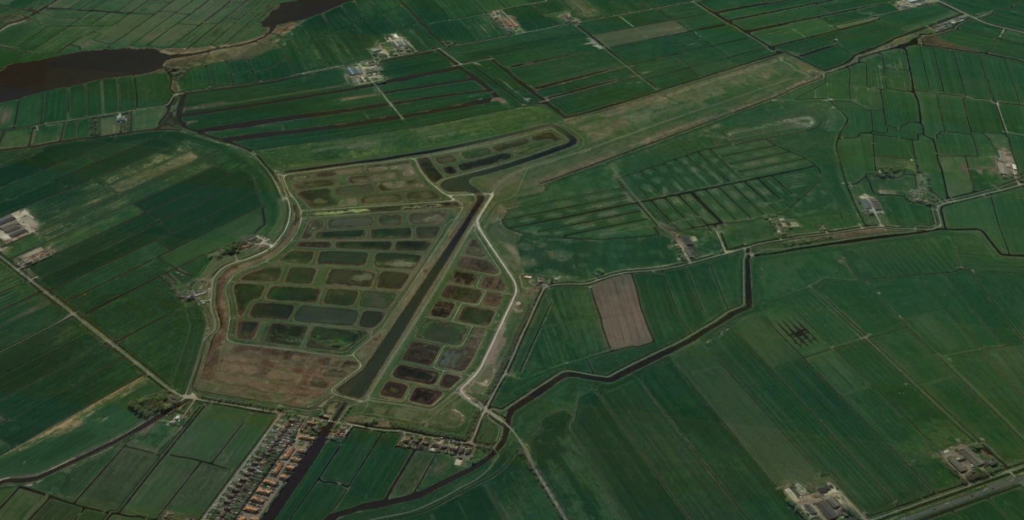Initiation
The Volgermeerpolder is an area of approximately 105 ha, located 5 km north of the city of Amsterdam in a marshy polder with shallow groundwater, open water and peaty soils. In the twentieth century the Volgermeerpolder was used as a dump site for domestic and industrial waste. This included large amounts of chemical waste, making it one of the most heavily contaminated areas in Western Europe.
In the 1970’s the discussion started about the risk of uncontrollable spreading of the toxic waste into the environment, which was thought to be only a matter of time. The heavily polluted landfill was considered a ‘chemical time bomb’. The Volgermeerpolder was put on the political agenda and closed in 1981. After closure, the local authorities took the initiatives towards remediation, under pressure of the ‘Burgerkomitee’ (a group of organized citizens). Starting point for the remediation was complete isolation of the site, in order to prevent the spreading of the pollution.
Over a period of more than 30 years, with a growing intensity in the last 5 years before remediation, the quality of the groundwater surrounding the Volgermeerpolder was monitored. This led to the insight that the waste did not pollute the groundwater in the surrounding polder system (peat meadows). It was concluded that the peat efficiently acted as a natural barrier and prevented spreading of the contaminants. This triggered the question whether the same material could effectively be used for capping.
Project Solution
For the capping an ‘Eco-variant’ was chosen, which should reduce contact risks and prevent waste spreading, but would also create conditions for developing a natural wetland. In 2001 the consortium ACV – Advies Combinatie Volgermeerpolder – started remedial planning and design for the Volgermeerpolder. The cap construction started in 2005 by covering the landfill with several surface sealing layers of soil and HDPE (high-density polyethylene) foil and was completed in 2010. The capping is now in the management phase.
After the discovery that peat acted as a natural barrier, it was decided that for remediating the Volgermeerpolder it would be sufficient to only cover the landfill and that complete isolation of the landfill or placement of a leachate-interception system was not necessary. The HDPE foil (used to cover the landfill) will normally have to be replaced after some time, due to leaks in the foil. To avoid this expensive operation, ACV developed the ‘natural cap’ concept, which boils down to a gradual, functional replacement of the standard cover (of soil and a synthetic foil) by a natural layer of peat that develops over time. In the Volgermeerpolder, the foil will not be removed because its leaking will not be a problem as its function is taken over by the developing peat layer. To start the peat development, swamp-like conditions are created on top of the cover in so-called sawas (paddy-fields), terrace-like basins inspired by Asian rice fields. These sawas facilitate water storage and accurate water level control.
The ‘natural cap’ concept has great potential for landfill remediation. In suitable areas, it is considered a sustainable and cost-effective remediation for a standard synthetic or concrete cap and thus a valuable contribution to the remediation of landfills in the Netherlands and abroad. It is based on the hypothesis that one can use the nominal lifespan of the initial synthetic foil (approximately 30 – 100 years) to let a natural peat layer develop which takes over the cap function. This hypothesis is based on research such as in the ‘Westbroekse Zodden’ in the Netherlands, where after 30 years a thick peat layer was formed.The ‘natural cap’ concept will not be applicable for every landfill remediation, it is for example very important that the soil can be kept in a wet condition. The circumstances for developing peat need to be present.

The BwN aspect
The use of natural processes to develop peat on top of the Volgermeerpolder has a lot of advantages. The peat landscape that will develop over the years is considered very attractive from an ecological and a landscape point of view. The many ponds initially present match well within the surrounding water-abundant landscape of ‘Waterland’ and the same goes for the future peat fields. The landfill can be considered an oasis of ecologically valuable nature within agricultural land use, with very high biodiversity and robust nature. Because of the ecological value, the landfill may fullfil many recreational purposes. Moreover, peat formation binds a significant amount of CO2. If successful, the ‘natural cap’ makes replacement of the standard cover unnecessary, thus avoiding considerable costs and disruption of newly developed nature. Therefore, this investment in natural capping is expected to yield a long-term return in the form of ecosystem services.
An effect which is difficult to value is that this project serves as a large-scale experiment on peat formation. It will produce knowledge that may enable scientists to tackle the problem of peat oxidation and the ensuing subsidence of lowland agricultural areas, like in the western part of the Netherlands.
In summary, the project is executed to provide the following ecosystem services:
- Seepage blocking
- Water buffer (because of the sawa (paddy field) structure)
- Recreation
- Nature values (species, habitat)
- Corridor for species such as the grass snake (Natrix natrix) (the grass snake is present in adjacent areas and was present in the Volgermeerpolder in the past)
- Degradation of toxic substances
- CO2 sequestration
